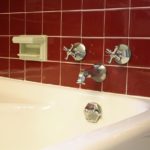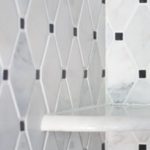
A nice, even bead of caulk provides the finishing touches where a neat tile installation meshes with a new tub.
Caulking materials are usually either latex, silicone or a combination of both. Tile installation in bathrooms, kitchens and laundry rooms – most anywhere indoors – requires the application of good caulk to seal edges, seams and boundaries.
Both common materials used as caulk come in two basic formats – a cartridge for large jobs and a tube for touch up and smaller jobs. The cartridge, teamed with a specialized application tool or “gun,” provides a more even, continuous bead than a smaller squeeze tube. A cartridge typically has 9-11 ounces of caulk while a smaller tube has from three to six ounces. Tubes are handy for tight spaces and smaller and touchup applications.
Prep for Caulking
While caulks seal seams and edges, they are not designed specifically as a sealant. The principle difference between a sealant and caulk is that a sealant is very elastic. Most caulks are rigid or stiff when dried. A caulk is specifically used in areas where there’s not going to be much expansion or contraction of the surfaces. On the other hand, sealants are designed to flex and are the choices for areas where movement is expected.
Advanced preparation is vital to a good caulking job.
TIP FROM A PRO — Using a caulk gun isn’t as easy as it looks. If you’ve never done it before, make your first effort in an area where it won’t show much, or better yet do a test run on a piece of scrap. Once it’s cured the caulk is hard to do over.
The first step in applying caulk to a tile installation is to consider where it will be used. Kitchen, bathroom and laundry applications need to resist water and mildew. Mold and mildew can stain cured caulk so resistant products are a must.
Temperature, humidity and moisture all affect the application of caulk. Because silicone is permanently waterproof, flexible and shrink-/crack-proof it has grown in popularity.
For a tile installation in a bathroom look for caulk labeled for tub and tile. They are specifically formulated for high-moisture areas and to resist mold and mildew
What the Future Holds
Some experts say that new formulations of caulking products will replace silicone while others say that isn’t likely to happen any time soon. Silicone has been the mainstay for more than 50 years. Consider Silicones advantages:
- Extremely strong
- Ideal for hard surfaces like glass, metal and tile – excellent for ceramic and porcelain tiles
- Withstands extremes
- Cures to a soft texture
- Remains flexible
- No harmful effects from UV exposure
- Resists most molds and mildew
- Can be applied in almost any temperature
Disadvantages of silicone as the basic ingredient in caulk:
- Can be difficult to apply with gun
- Requires solvents for cleanup
- Most cannot be painted
- Damaged silicone caulk tears easily and cannot be repaired – must be removed and redone
- Require good ventilation when it’s going on – not toxic but has a strong odor
Compare to Latex Caulking
Latex caulk, also known as “painters caulk” and often labeled as “Latex/Acrylic Caulk” is a strong contender for use in most tile installation or remodeling projects. It’s advantages when compared to silicone include:
- Easier to work with and apply
- Can be replaced with less work if it is damaged
- It can be painted – some come in colors
- Tools and surfaces are cleaned with soap and water
- Little or no odor during application
- Applies to porous and nonporous surfaces
Among the disadvantages are:
- It weakens when subjected to extreme temperatures
- Weaken when exposed to direct sunlight
- Can shrink and crack over time
Professional Advice Makes Choices Clear
For creative tile installation ideas and options, contact Molony Tile, a source for unique, durable and elegant tile solutions in Madison WI and greater Dane county
Call or email Molony Tile, 608-268-8453 to discuss tile installation projects and select the perfect caulking options, materials and techniques for your Madison WI home.


